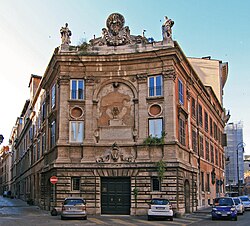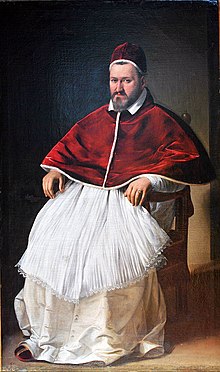Banco di Santo Spirito

The Bank of the Holy Spirit (Italian: Il Banco di Santo Spirito) was a bank founded by Pope Paul V on December 13, 1605. The bank was the first central bank in Europe (as the bank of the Papal States) at a level above city-states,[1] the first public deposit bank in Rome,[2] and the oldest continuously operating bank in Rome until its merger in 1992.[3]
First period (1605–1923)

The Bank was founded by Pope Paul V in the Bench of S. Spirit building (which became known as the Palazzo del Banco di S. Spirito) on December 13, 1605.[4] The construction of the building was started in 1513 by Pope Leo X, on what became known as the "Street of the Banks."[5] The newly founded bank provided a new source of income for the Archhospital of Santo Spirito (founded 1201),[6] whose financial difficulties had been increasing throughout the 16th century, and in 1607 the bank began supervising the finances of the hospital, which owned the bank.[2]
From February 20, 1606, to 1923, the Bank of the Holy Spirit provided capital for churches and hospitals constructed in Rome, and other commercial purposes. The bank lent funds to several public works projects, including the Trajan aqueduct project (Begun 1608).[6]
In 1750,
The records of the Bank are extant in the
1923–92
In 1923, the Bank was reorganized as a joint-stock company. In 1935, the Istituto per la Ricostruzione Industriale (IRI) of the fascist Italian government gained a controlling interest in the bank.
In the 1930s, Neapolitan bank robbers attempting to dig into the underground vaults of the Bank accidentally discovered the skeletons of victims of an 1836 cholera epidemic, which after archeological excavation became known as the Fontanelle cemetery.[9]
Merger
In 1992, the Bank of the Holy Spirit—which had previously merged with the
See also
- Vatican Bank
- Banco Ambrosiano
References
- ISBN 0-02-864234-1. p. 106.
- ^ a b Freiberg, Jack. 1991. "Paul V, Alexander VII, and a Fountain by Nicolò Cordier Rediscovered." The Burlington Magazine 133 (1065): 833–843.
- ^ Fodor's Online Travel Guide. 2007. "Touring Old Rome."
- ^ (in Italian) Piperno, Roberto. "SS. Celso and Giuliano."
- ^ Copetas, A. Craig. 1997, April 18. "Travel: Guide Is Key to Italy's Ancient Banks --- `Forma Urbis' Unearths Many Unusual Gems." The Wall Street Journal.
- ^ a b Cohen, M. 1994. "Capitalia S.p.A." International Directory of Company Histories 65.
- ISBN 0-7864-1450-2. p. 317.
- ISBN 0-7607-0125-3. p. 136.
- ISBN 0-8112-1529-6.
- ^ Who's Who in Italy. "Banca di Roma."
